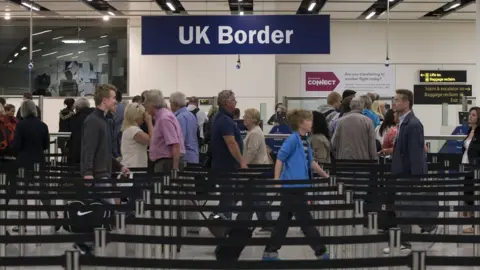Migration figures: Highest number of EU nationals leaving UK in a decade
 Getty Images
Getty ImagesThe number of EU citizens leaving the UK is at its highest level for a decade with 130,000 emigrating in the year to September, figures show.
But far more EU nationals (220,000) moved to the UK in the same period, the Office for National Statistics found.
It means net EU migration - the difference between arrivals and departures - was 90,000, the lowest for five years.
The ONS said Brexit could be a factor in people's decisions to move.
Nicola White, head of international migration statistics at the ONS, said migration was complicated and could be influenced by lots of different reasons.
The figures also show that more British people are emigrating than are returning to live in the UK.
Of those EU nationals arriving in the UK, fewer were coming for "work-related reasons", in particular to "look for work".
'More students'
By contrast, immigration from countries outside the European Union is going up which means the UK population is continuing to grow at a similar level to early 2014.
Some 285,000 non-EU citizens arrived in the UK in the 12-month period to September, and 80,000 departed.
This gives a net increase of 205,000, the highest for six years.

BBC home affairs correspondent Danny Shaw said this was largely driven by more people coming to study in the UK and an uncharacteristic dip in the previous year's figures that may have been corrected.
He also speculated whether firms were starting to struggle to recruit or retain people from the EU, forcing them to look outside the EU.
Overall, net migration is estimated to have fallen by 29,000 to 244,000 in the same period.
This includes 73,000 British people coming back to the UK and 125,000 Britons leaving.
The overall net migration figure is still well short of the government's target to reduce net migration to below 100,000, a pledge made in the 2010, 2015 and 2017 Tory manifestos.

Analysis: A shift away from Britain's shores
By home affairs correspondent Danny Shaw
What explanation could there be for the decline in EU migration other than Brexit? In the two years before the June 2016 referendum, the number of EU nationals arriving in Britain was stable at about 240,000 to 280,000.
But every quarter since then has recorded falls, from 284,000 to 220,000.
At the same time, the number of EU leavers, which hadn't risen higher than 100,000 since 2010, began to rise, from 95,000 to 130,000.
Whether it's a feeling that EU citizens aren't wanted in the UK, uncertainty about their future or the growing relative strength of other EU economies, there has been a notable shift away from Britain's shores.
Nevertheless, overall net migration remains at historically high levels, well above the government's controversial target, with a rise in migration from outside Europe.

Caroline Nokes, immigration minister, said the latest figures demonstrated that the UK was still attracting the "brightest and best people" to come to work and study and described the increase in the number of overseas students as a "huge positive".
"We are a country that is open for business," she added.
"We want to have great relations with our European neighbours going forward but at the same time we need to have a sustainable migration system," she said.
Asked whether falling numbers would adversely affect some sectors, in particular the NHS, Ms Nokes said the independent migration advisory committee was due to report its findings on EU patterns to the government in September so decisions could be made based on evidence.


You might also be interested in:

Labour's shadow home secretary Diane Abbott said net migration was still double the government's target and accused the Home Office of turning away qualified doctors despite a recruitment shortage in the NHS.
"This deficit hurts us all and highlights the immigration mess the government has created," she said.
The ONS figures also show that in 2017, the UK granted asylum, alternative forms of protection or resettlement to almost 15,000 people, 40% of whom were under 18.
Separate figures from the Home Office showed more than 10,500 people have been granted refuge in the UK after fleeing the conflict in Syria, under the Vulnerable Person Resettlement scheme.
Home Secretary Amber Rudd, who is in Lebanon near the Syrian border, said the government was considering extending its commitment to rehome 20,000 people by 2020.
Other figures from the Home Office show there were 141,302 applications made for British citizenship in 2017, an increase of 8% on the previous year.
This was 39% lower than the peak of 232,262 in 2013.
There is evidence that more EU citizens, who have settled in the UK, are applying for citizenship, with applications more than doubling from 15,460 in 2016 to 38,528 in 2017.
